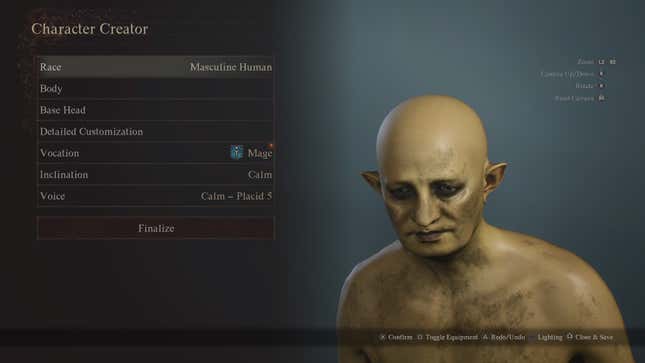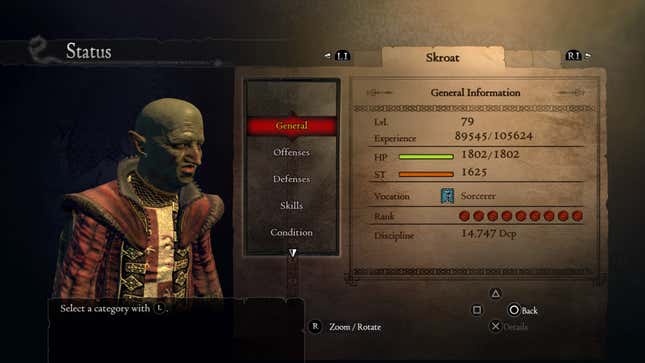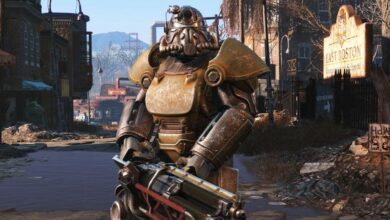Dragon’s Dogma 2: The Kotaku Review

I can’t believe Dragon’s Dogma 2 exists.
I can’t even believe the first Dragon’s Dogma exists. The game was already out of step with best practices for open-world RPG design when it released back in 2012, and its choices feel only more radical with age: oblique fast-travel mechanics, circuitous questlines that are almost as easy to fail as they are to miss entirely, staunch insistence on not allowing players direct control over the majority of their adventuring party.
Buy Dragon’s Dogma 2: Amazon | Best Buy | Humble Bundle
It bore all the hallmarks of a passion project, and it was. Director Hideaki Itsuno, having helmed three entries in the Devil May Cry series (which completely upended and revolutionized action game paradigms), had finally been given the green light—and the requisite technology—to direct the sprawling, systems-heavy action RPG he’d been conceptualizing since the turn of the millennium. The final result was uneven, occasionally overwhelming, and replete with concepts clearly intended for a project with a larger scope. It was also—in spite of and often because of its jaggedness—astonishingly rich. Acclimating myself to the singular rhythms of Dragon’s Dogma, unspooling its structure and glimpsing the inventiveness of its byzantine design, is one of the most rewarding experiences I’ve ever had with a game.
Twelve years later, the existence of Dragon’s Dogma 2 provokes a simple question: can you make Dragon’s Dogma now? Much ado has been made about Capcom’s latest supposedly being a truer realization of Itsuno’s original vision. What does that vision look like, in an era where open-world games are still largely defined by painless fast travel and quests structured like tax return forms? How do you “modernize” a design that, by its very nature, resists modern design?
In short, you don’t. My impression coming away from Dragon’s Dogma 2 is that, throughout the past decade of seismic triple-A releases, Itsuno has been holed up in an underground bunker somewhere, scrupulously taking notes–not on his contemporaries, but on Dragon’s Dogma. Dragon’s Dogma 2 is a game unburdened by any influence save that of its own predecessor; it is, on every level, a supremely confident melding of ideas; it contains at least a little bit of everything I’ve ever loved about video games.
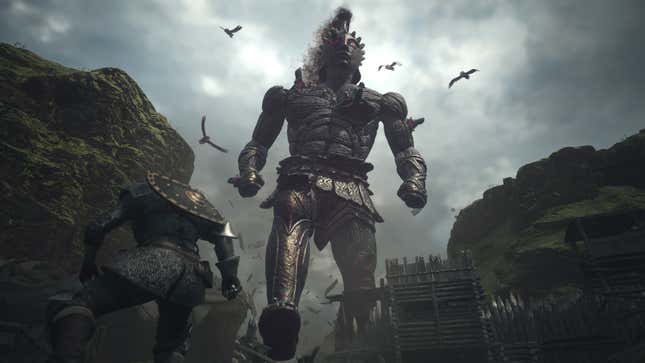
Pawn Stars
The premise here is wonderfully straightforward (and immediately recognizable to anyone familiar with the first Dragon’s Dogma): since time immemorial, a vicious dragon has wreaked devastation on the land of Vermund, personally choosing one warrior per generation to oppose it. This warrior, dubbed the “Arisen,” is able to command “pawns,” humanoid beings with no wills of their own whose only purpose is to aid the Arisen’s dragonslaying efforts by whatever means possible. Much of the game’s drama is derived from its decrypting of these roles, and of the hierarchies of power—both political and cosmic—separating them.
The pawn system is why Dragon’s Dogma was made. When Itsuno first pitched the project, it was under the working title “BBS RPG”—a reference to bulletin board systems, pre-World Wide Web servers that facilitated software exchange and personal communication between users. In essence, he wanted to bottle the strange, murky sensation of early Internet forum browsing, of forging relationships with people who you can only perceive as text on a screen. So he created the pawns.
Players can have up to three pawns in their party at a time, though one of these slots will always be occupied by their “main pawn,” one they design and assign a role to themselves. The remaining two are “hired” from other players via an asynchronous online system (not unlike a modern BBS). Pawns can be influenced, but they cannot be directly controlled, by yourself or anyone else.
Dragon’s Dogma 2 is, very purposefully, single-player. Forging connections with your pawns despite your inherent distance from them is key to everything the game is doing. These video game characters in the truest sense, narratively and metanarratively stripped of agency and existing in a state of constant, near-total deference to the player. Every facet of their implementation underscores this tension: the more attached to them you become (and the more they learn from your behavior and begin acting on their own), the more ambiguous your sway over them feels. Are you their commander, or their equal?
When I made my main pawn in the first Dragon’s Dogma—a nasty, sullen, five-foot-nothing goblin man named Skroat—it was as a joke. I wasn’t too sure how pawns were supposed to work, and figured it would be pretty funny to have a hideous little butler following me around everywhere. When I remade Skroat in Dragon’s Dogma 2, it was with barely a shred of irony. Watching him emerge from the aether in crisp 4K, weathered green skin glistening in the sunlight, was like meeting a childhood friend at the airport. Something had shifted almost imperceptibly in the thirty-odd hours I spent on my first playthrough of Dragon’s Dogma, and I finished the game accompanied not by a manservant, but a trusted ally.
Such is the magic of the pawn system: the game recognizes that your investment in your pawns is predicated on a delicate balance between how much they do and don’t obey you. When they follow your orders in battle, retrieve treasure for you, and help guide you toward quest destinations (often utilizing knowledge gleaned from their own Arisen’s travels), they feel like teammates. When they run off on their own into packs of wolves, pick so many berries that they become overburdened, and spout phrases as thuddingly obvious as “Different combinations of materials result in different creations!”, they feel like people. In Dragon’s Dogma 2, there’s a far greater emphasis on them conversing amongst themselves, enhancing the illusion (and the tension) even further. This is a world that decenters you, even when it’s supposedly meant to serve you.
Sweet Surrender
Dragon’s Dogma 2’s key ingredient is that it resists you at nearly every turn. Not because it’s challenging (it is, though that’s never the point), but because it insists that you meet it on its own terms. Navigating Dragon’s Dogma 2 takes effort more often than it takes skill. The game applies an intuitive and consistent logic to its world, eases you into understanding it, and then sets you free, trusting that when you do encounter resistance, you’ll rise to the occasion.
The most conspicuous (and publicized) example is its limited pool of traversal options. As in the first game, the (exceedingly few) fast travel points on the map can only be warped to via the use of “ferrystones,” single-use consumables that are very rare and expensive. Even rarer are “portcrystals,” which let players create fast-travel points of their own. Across my entire playthrough, I found three.
When setting out for the day, you have several choices. Often, you’ll opt for the most obvious one, and huff it on foot. There’s a lot of walking in Dragon’s Dogma 2, and usually, after reaching your destination, you’ll need to walk back. It’s a deliberate, time-consuming process, and I wouldn’t change a thing about it. Both Dragon’s Dogma games are, for me, perhaps the closest this medium has ever come to palpating the feeling of being on a hike. Environments are rarely wide open, and there’s a strong emphasis here on dense, tiered level design. The game is epic not necessarily in scale but in sheer volume; it plots its sinuous mountain roads with subatomic care, seeding a little more familiarity each time you cross them. Even now, having played Dragon’s Dogma 2 only one (and a half) time(s), I can close my eyes and picture the routes between several of its landmarks with almost perfect clarity.
Buy Dragon’s Dogma 2: Amazon | Best Buy | Humble Bundle
Sometimes, you’ll have other options. If (and that’s a big if) there’s a portcrystal at your destination, you can warp there, provided you have a ferrystone. If (another big if) your destination is along an oxcart route, you can toss the driver a few gold to hitch a ride, and once aboard, either doze off (which, after a fade to black, skips you straight to the end of the journey) or just watch the wilderness roll by. (Staying awake makes oxcart trips excruciatingly slow. I can’t believe it’s even an option. I love it so much.)
Each method carries its own set of risks, and every decision you make cascades into a series of progressively more interesting decisions. For instance, if you walk, you’ll need to bear equipment load in mind, and potentially pack camping kits (which are very heavy) in case you don’t reach your destination before sunset (nighttime is pitch-dark and extremely difficult to navigate; additionally, your maximum health depletes the longer you stay awake). Oxcarts may seem like the obvious choice, but there’s always a chance that you’ll be ambushed along the road–sometimes by monsters ferocious enough to destroy the cart entirely, leaving you stranded in the middle of potentially unmapped territory.
None of this is guaranteed to happen, but there’s always a chance it could. Occasionally, it can be frustrating, not because it’s unfair, but because you understand that you should have known better. The game is frictive in ways that warrant consideration instead of force. As limited (and generally meaningless) as “immersion” is as a barometer for a game’s quality, it feels apt here: Dragon’s Dogma 2’s mechanical tapestry organically, almost invisibly places you in a gameplay loop encompassing every possible stage of adventure. Preparation, navigation, combat, resource management, and, most vitally, rest.
Sidewinding
I adore the combat system in Dragon’s Dogma 2, which is designed by one of the most talented action-game development teams in the world. Each of its classes (“vocations”) wields a different weapon, and each weapon is a precision-tuned character action moveset in its own right. I love that the weapons all have wholly distinct “shapes” to their movements, so striking and memorable that they could easily be drawn on paper. Thief is a rough, acutely-angled zigzag. Warrior is a hard press of the pen, and then a bold, arcing stroke upward just as the ink is about to bleed through the page. Mystic Spearhand is a series of sweeping loops with a perfectly straight line puncturing their center. Magick Archer is a spiral, starting from the outside and honing into a gradually shrinking field of fixed points. And so on.
Combat is also, somehow, the least important part of the game. It’s far from the least interesting part of the game, and you’ll certainly be doing a lot of it, but the developers clearly didn’t want it to be your primary mode of engagement with their world. Where elsewhere Dragon’s Dogma 2’s systems are granular and unpredictable, combat is extremely straightforward. There are health bars, but no visible numbers outside of menus. Weapon skills, magic(k), and sprinting all draw from the same resource. Changing vocations is breezy and automatically reallocates stats. The game’s closest cousins aren’t contemporary RPGs, but Capcom arcade beat ’em ups: I was reminded at turns of Black Tiger, Dungeons & Dragons: Shadow over Mystara, and especially Magic Sword. The action is razor-sharp, responsive, malleable, and perfect. It’s the work of someone who, by his own admission, played turn-based games as a student and wished that all the battles could be replaced by Street Fighter II. But it’s not what Dragon’s Dogma 2 is about.
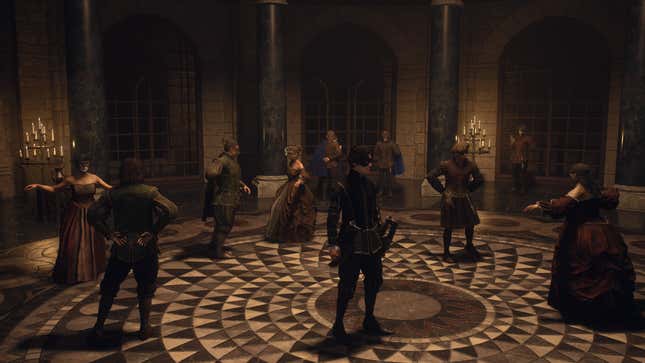
Dragon’s Dogma 2 is about quests. Specifically, it’s about quest design. It’s about talking to dozens of characters and, over time, intuiting how the lattices of their stories connect and overlap. A choice in one corner of the world might somehow trickle down to another. One of the first suggestions you’re given upon arriving in Vernworth—Vermund’s royal capital, and the game’s central hub—is to ingratiate yourself to the city’s citizens and help them with their problems.
I remember the precise moment I began to comprehend the (frankly paralyzing) complexity of the original Dragon’s Dogma’s quest design. As a result of cramming a lot of big ideas into a comparatively small space, the game frontloads a tsunami of sidequests in its opening half hour. “Okay,” I thought, “I’ve played RPGs before. I know how this works. I’ll save these for later.” So I ignored most of them and progressed the campaign. As soon as I hit the next major beat, I got a string of notifications indicating that I’d failed about five quests. Apparently, the game was already hard at work shuffling pieces around in the background, and now there were vast portions of it I’d never get to see. I was baffled, and expressed as much to the friend I was on call with at the time, a longtime fan of Dragon’s Dogma who had been watching me play. “Yeah,” they responded. “What, did you think this was some sort of video game?”
There’s no directly equivalent moment in Dragon’s Dogma 2—the game has far more space to acclimate players to its structure—but its design philosophy is largely identical. This is not, in fact, just some sort of video game. It demands that you recalibrate your comfort level almost immediately.

There are no NPC quest indicators, for one. You won’t know if a character—any character, of the hundreds wandering around the game’s world—has work for you until either you speak with them or they flag you down. Quests in Dragon’s Dogma 2 are always very specifically requests—NPCs may inform you of rumors they’ve heard or mysterious places they’ve discovered. But unless they’re explicitly asking for your help, you’ll have to remember the information yourself. Quest waypoints follow the same logic (again, that logic, that crystalline, airtight logic that girds every inch of this wonderful game): if a questgiver doesn’t know the location of the item they’re asking you to retrieve, they won’t mark it on your map for you, because how could they? One quest, a personal favorite, involved an NPC running up to me and asking me if I could help him find his lost orb. Okay man, no problem. I’ll find your orb. QUEST ACCEPTED: Find The Orb. I opened the map; no markers. Good luck!
There’s always, always a wrinkle, always something complicating a task that initially seems straightforward. Even the simplest quests have some lasting, tangible effect—maybe a shopkeeper you helped out gives you a permanent discount, or maybe a monster-culling quest ends with someone being banished from their village for their failure to protect it. The world constantly shifts under your feet, changing around you (but not always for you). Frequently, quests string directly into one another. Sometimes, the completion of one makes another possible, but you won’t realize how for ten or twenty more hours. On multiple occasions in my playthroughs, sidequests directly affected how events unfolded in the main quest (on that note, there are no clear demarcations between the two in the quest log; they are, as far as the game is concerned, equally important).
And so often, there’s an element of patience. Of rest. That town is safe for now, but follow up on it “later.” You helped the little girl put together a bouquet of flowers, check in on her in “a few days.” Royal masquerades are held “sometimes,” and you need to attend one of them. When Dragon’s Dogma 2 asks you to wait, it means it. Each in-game day feels impactful, even when it’s only because there’s less time between you and your next objective. Every decision matters, even and especially when that decision is just being. Buying townsfolk a round of ale at the tavern. Warming yourself by a campfire with your pawns. Standing silently atop a griffin’s back as it soars through the air, granting you both a brief reprieve from battle.
Watching Dragon’s Dogma 2 spin its web is immensely rewarding. I won’t pretend all of its systems are novel, but its greatest strength is its resolute belief that every decision it’s making is the correct one. It is a shockingly confident, personal work. I’d call it a contender for game of the generation, but what would be the point? Dragon’s Dogma 2 doesn’t demand comparison. It merely shows up, works its magic, and takes a bow.
Crucially, my experience with the game is incomplete, and everyone else’s will be, too. It’s built for replayability, but it’s also built for collective mapping and interpretation. I can’t begin to comprehend on my own how many variables and alternative outcomes are at play here, especially given the game’s intentionally restrictive save options (one save slot, limited manual saving; when you make a decision, you need to stand by it). One particular mechanic I don’t believe I saw at all: “dragonsplague,” a disease pawns can contract as they pass through various game worlds that, supposedly, has cataclysmic effects if left unattended. I still don’t know what dragonsplague does, because I played Dragon’s Dogma 2 pre-release, and not many of the available pawns were player-made. (Big ups, though, to the few people who did hire Skroat. He and I both appreciated it.)
A couple days from now, the game will release, the floodgates will open, and the bulletin board system will begin firing on all cylinders. The Dragon’s Dogma 2 I played will not be the Dragon’s Dogma 2 you play. Let’s talk about it.
Buy Dragon’s Dogma 2: Amazon | Best Buy | Humble Bundle
.
Source link

